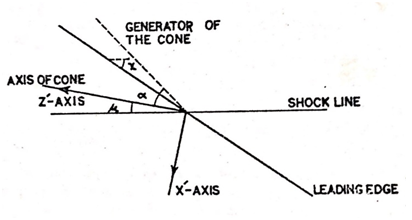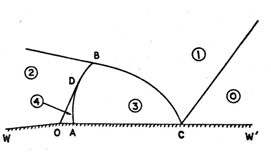Let the velocity pressure, density and sound speed ahead of the shock wave be denoted by
in the intermediate region by
and behind the reflected shock by
. Let U denote the velocity of intersection of the incident and reflected shock, δ the angle of the bend,
is the angle of incidence and
is the angle of reflection. The Rankine-Hugoniot equation across incident and reflected shock for
(g being the ratio of specific heats are gives as follows Srivastava.8,9 Across the incident shock (Figure 1).
(1)
(2)
(3)
Across the reflected shock
(4)
(5)
(6)
Where
Also we have
As the oblique shock configuration advances over a yawed wedge (shock line making some non zero angle with the leading edge of the wedge) the velocity of the point of intersection of the leading edge and shock line moves with velocity
, U being the velocity of shock line and
being the angle of yaw (Figure 2).
By superimposing a velocity on the whole field in a direction opposite to the direction of motion of the point of intersection of the shock line and the leading edge, the shock configuration becomes stationary and the resulting velocity behind the reflected shock for stationary configuration say V2 is given by
(7)
For conical field flow to occur behind the reflected shock
should be greater than 1 which from (7) gives the condition that we should have
(8)
We have also the relation
(9)
Further the semi angle of the Mach cone is given by
(10)
Let the disturbed flow variable behind the reflected diffracted shock referred to
axes be denoted by
(11)
where
are small perturbation in the velocity along
and respectively,
is the pressure,
is the density and
is the entropy. Using conservation laws we obtain the flow equations as
(12)
(13)
(14)
We introduce the following transformations
M
(15)
(16)
The characteristics of equation (16) are tangents to the unit circle
which in
axes becomes the cone
The region of disturbance will therefore be bounded by cone of disturbance, the shock front and the wall of the wedge (Figure 3).
The position of the shock line referred to
system is vand it will lie inside on the cone of disturbance and outside the cone of disturbance according as
(17)
and (18)
Following Chopra & Srivastava,7 the undisturbed part of the reflected shock lies in the plane
,
(19)
The equation of the reflected diffracted shock may therefore be written as
(20)
where is small
The radius of curvature
is given by
(21)
Using equation (20), we obtain
(22)
Following Srivastava,7 we have
(23)
Equation (23) gives
(24)
Combining (22) and (24) we have
(25)
Following Srivastava2 and Srivastava & Chopra3 we have
(26)
From (25) and (26) we have
(27)
We have the relation
, (28)
and
, (29)
Following Chopra10 and Srivastava11 the relation between Z and
is given by
(30)
where
and
From (30) we obtain
(31)
In (28)
is substituted in terms of
actually in terms of
as on the real axis ,being equal to
, we will then obtain
The numerical values for the calculation are
These data provide
(subsonic)
The solution of the problem is obtained by the introduction of the complex function
(32)
is given by Chopra10
(33)
where
(34)
(35)
(36)
The curvature from (27) can be put in the form
(37)
On the shock from
(
being zero) and varies from
to
.
The real part on the right hand side of 33 with
replaced by
gives the value of
.
As mentioned earlier
is obtained from (28). Now that
is known and
is known then from (37)
is known. We therefore have obtained final expression for
.
We have the relation
when
.
So from the relation (28)
So
when
, then we have
We have then
or
So in the final analysis
(
i.e.
)
and

Figure 1 Oblique shock configuration.

Figure 2 Configuration after interaction in the x′-z′ plane

Figure 3 Flow picture in a plane perpendicular to the axis of the cone of disturbance.


